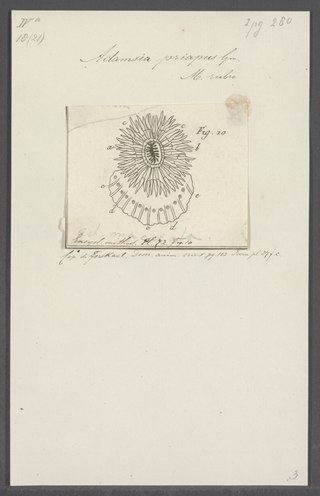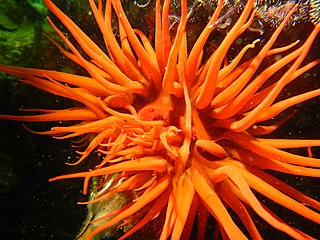
Calliactis is a genus of sea anemones. Species in this genus are mutually symbiotic with hermit crabs. The anemone gets a place to live and discarded scraps of the crab's food in exchange for its help in defending the crab.

Edwardsia is a genus of sea anemones, the type of the family Edwardsiidae. They have eight mesenteries and live in tubes in the sand. The name, in Neo-Latin, commemorates the French zoologist Henri Milne-Edwards.

Sea anemones are a group of predatory marine invertebrates constituting the order Actiniaria. Because of their colourful appearance, they are named after the Anemone, a terrestrial flowering plant. Sea anemones are classified in the phylum Cnidaria, class Anthozoa, subclass Hexacorallia. As cnidarians, sea anemones are related to corals, jellyfish, tube-dwelling anemones, and Hydra. Unlike jellyfish, sea anemones do not have a medusa stage in their life cycle.

Adamsia is a genus of sea anemones in the family Hormathiidae. Species in this genus are mutually symbiotic with hermit crabs. The anemone gets a place to live and discarded scraps of the crab's food in exchange for its help in the crab's defence. As these anemones grow, they secrete a horny membrane, known as a carcinoecium, which overlies the crab's original snail shell and expands the living space of the crab. This means the anemone does not have to change substrate and the crab does not have to seek a larger shell as they both grow.

Isanthidae is a small family of sea anemones in the class Anthozoa.

Edwardsiidae is a family of sea anemones. Edwardsiids have long thin bodies and live buried in sediments or in holes or crevices in rock.

Boloceroides daphneae is a cnidarian which occurs in the depths of the East Pacific Rise and was described in 2006.

Daphne Gail Fautin was an American professor of invertebrate zoology at the University of Kansas, specializing in sea anemones and symbiosis. She is world-renowned for her extensive work studying and classifying sea anemones and related species. A large sea anemone-like cnidarian species has been named in her honor, originally called Boloceroides daphneae, but recently renamed to Relicanthus daphneae, after it was discovered to belong to a previously unknown cnidarian order. Fautin has published numerous scientific articles and texts—including co-authoring Encyclopædia Britannica's entry on cnidarians—and her publications have been widely cited by other researchers in the field. Among her current positions, she is the curator of the University of Kansas Natural History Museum and serves as vice president and commissioner of the International Commission on Zoological Nomenclature, overseeing the naming of new species.
Actinernoidea is a superfamily of sea anemones in the order Actiniaria, Until 2014, this taxon was considered to be a separate suborder of the order Actiniaria.
Anenthemonae is a suborder of sea anemones in the order Actiniaria. It comprises those sea anemones with atypical arrangement of mesenteries for actiniarians.

The Enthemonae is a suborder of sea anemones in the order Actiniaria. It comprises those sea anemones with typical arrangement of mesenteries for actiniarians.

Actinostoloidea is a superfamily of sea anemones in the order Actiniaria.
Actinioidea is a superfamily of sea anemones in the order Actiniaria.

Metridioidea is a superfamily of sea anemones in the order Actiniaria. Members of this clade live in shallow subtropical waters worldwide.
Antipodactinidae is a family of sea anemones.
Kadosactinidae is a family of sea anemones.
Phelliidae is a family of sea anemones.
Halcampulactidae is a family of sea anemones belonging to the order Actiniaria.

Anemonia alicemartinae is a cryptogenic species of sea anemone found on the rocky shores of north and central Chile. It has an eye-catching bright red color with bud-like structures. It is an anthozoa in the actiniidae family and is very similar to Anemonia natalensis and Pseudactinia varia from South Africa.









